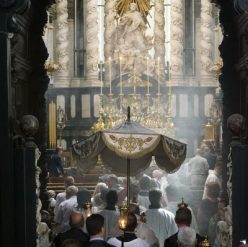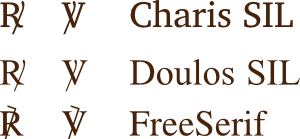The Vatican editions of the liturgical texts use to contain some glyphs which are specific to the liturgy. One of these symbols is called responsum (an R with a diagonal bar) and another one versiculum (a V with a diagonal bar).
If you use a recent browser (i.e. Firefox 3 or later, Internet Explorer 4 or later, Chrome 4 or later, Safari with Webkit), you will see these glyphs here: R and V. Otherwise you will see only the letters R and V in red.
With some luck, your system can render the Unicode chars ℟ and ℣ by default, like in this sentence. If you don’t see these chars in the previous sentence, it means it doesn’t work.
This website offers the liturgy.ttf font containing these liturgical characters: see here. The chars are located at the same place as R (capitalized) and V (capitalized), which is not the standard place to encode these, but it provided useful fall-back on old systems without Unicode encoding.
- link to download liturgy.ttf
Later, the Unicode encoding system implemented the glyphs response and versicle and allocated a specific code for these: U211F and U2123. The question now is to find Unicode fonts having these characters actually implemented.
Since Unicode became a de facto standard on most Linux distributions, we will find more and more open source fonts containing response and versicle at the corresponding place of the Unicode encoding. We will list only serif fonts available under GPL license below:
- link to download Charis SIL
- link to download Doulos SIL
- link to download FreeSerif
Ubuntu and Debian users can click on following links for easily installing the fonts with the package manager:
- link to install Charis SIL
- link to install Doulos SIL
- link to install FreeSerif
Another place where we found the response and versicle characters, are the software and fonts related to Gregorian chant.
- The Meinrad Abbey provides such a font but it is not open source.
- The Gregorio software for engraving plain chant offers the response, versicle and even antiphon glyphs. The filename of the font is gresym.pfb. This is the link to download the font gresymb.pfb alone. If you have installed Gregorio on your computer, you will find the font files in a subdirectory of Gregorio called fonts.

